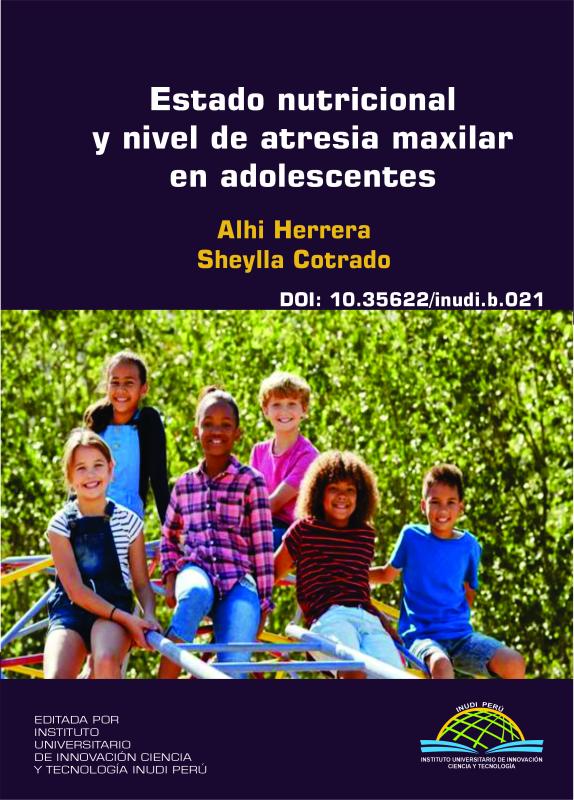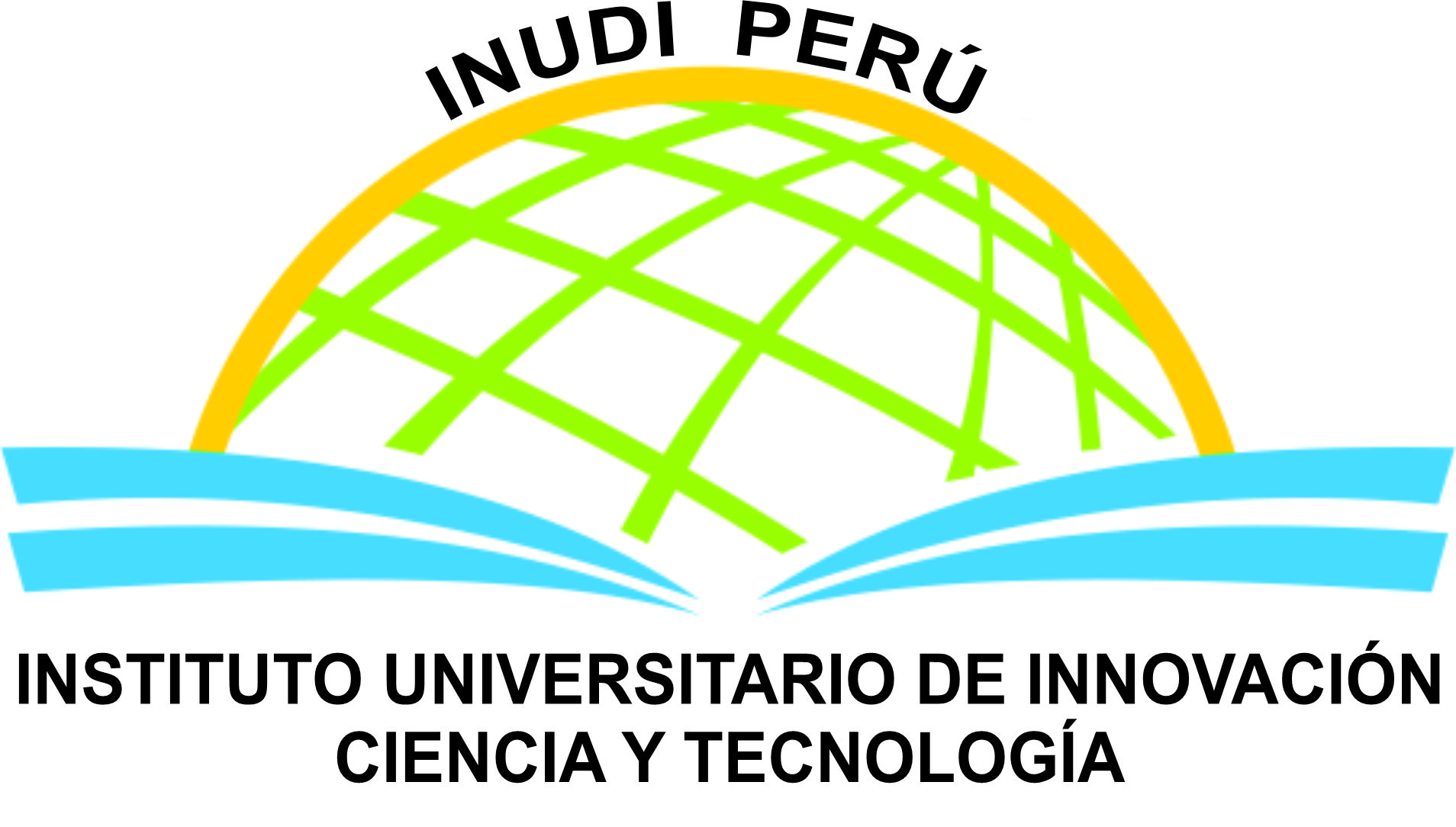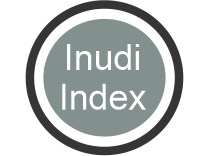Nutritional condition and level of maxillary atresia in adolescents
Keywords:
nutritional status, maxillary atresiaSynopsis
This book is an adaptation of a research presented at the Universidad Andina del Cusco, whose objective was to establish the correlation that exists between nutritional status and maxillary atresia. With a quantitative approach, non-experimental, correlational design with transversal temporality. The study population whose random sample was selected 30 children and 30 children in age groups from 10 to 12, 13 and 14 years respectively from the community of Qollana in the district of San Jerónimo (Cusco – Peru). Anthropometric measurements of the body mass index were carried out by measuring weight and height to determine the nutritional status and, in turn, measurements of intercanine and intermolar angles were carried out in study models to determine maxillary atresia for the analysis of results, using the ANOVA and ANOVA test. chi squared with a significance level of 0.05. The results show that regarding the nutritional status with the age, significant differences were found between the female sex (p=0.013<0.05) and the male sex (p=0.0740>0.05). Maxillary atresia was 46.7% female and 51.7% male. No significant differences were found when comparing maxillary atresia between males and females (p = 0.438 > 0.05). It is concluded that by relating the maxillary atresia with the nutritional status in the female sex at 12 years old, there is a relationship with respect to the intermolar angle at 13 and 14 years with respect to the intercanine angle. In the male sex at 13 years old, there is a relationship between both the intercanine and the intermolar and the 14 years only with the intermolar angle in the upper jaw.
References
Ward DE, Workman J, Brown R, Richmond S. Changes in arch width: A 20-year longitudinal study of orthodontic treatment. Angle Orthod. 2006 Jan;76(1):6–13.
Cross DL, McDonald JP. Effect of rapid maxillary expansion on skeletal, dental, and nasal structures: A postero-anterior cephalometric study. Eur J Orthod. 2000;22(5):519–28.
Moreno K, Meneses A, Morzán E. Dimensiones de arcos dentarios en niños de 4 a 8 años de edad con diferente estado nutricional. Talara - Piura. Rev Estomatológica Hered [Internet]. 2014 Sep 29;14(2–1):18–21. Available from: https://revistas.upch.edu.pe/index.php/REH/article/view/2004
Donayre Alvarez JA, Durand Diez F, Espinoza Peña CA. La erupción de las primeras molares e incisivos permanentes según el estado nutricional en niños de ambos sexos de 5 a 7 años de edad en la provincia de Ica- Perú 2009. Universidad Nacional San Luis gonzaga de Ica; 2010.
Izquierdo A, Armenteros M, Lancés L, Martín I. Alimentación saludable. Rev Cubana Enferm [Internet]. 2004;20(1). Available from: http://scielo.sld.cu/scielo.php?script=sci_arttext&pid=S0864-03192004000100012
Nelson WE (Waldo E, Kliegman R. Nelson textbook of pediatrics. Elsevier/Saunders; 2011. 2610 p.
Puerto L, Tejero P. Alimentación y nutrición: repercusión en la salud y belleza de la piel. Nutr clínica y dietética Hosp [Internet]. 2013;33(2):56–66. Available from: https://revista.nutricion.org/PDF/ALIMENTACION-NUTRICION.pdf
Hernández M. Recomendaciones nutricionales para el ser humano: actualización. Rev Cuba Investig Biomédicas. 2004;23(4).
Martinez M, Soto A, Bellido D. Recomendaciones nutricionales en las distintas etapas de la vida basadas en la evidencia. Endocrinol y Nutr [Internet]. 2005;52(2):25–33. Available from: https://www.elsevier.es/es-revista-endocrinologia-nutricion-12-articulo-recomendaciones-nutricionales-distintas-etapas-vida-13088201#affa
Ávila-Rosas H, Aedo Á, Levin-Pick G, Bourges-Rodríguez H, Barquera S. El agua en nutrición. Perinatol Reprod Hum [Internet]. 2013;27(Supl. 1):31–6. Available from: https://www.medigraphic.com/pdfs/inper/ip-2013/ips131e.pdf
Ayaúcar A. Requerimientos nutricionales de energía y macronutrientes [Internet]. 2018. Available from: https://ruc.udc.es/dspace/bitstream/handle/2183/11336/CC-77 art 5.pdf
Cusminsky M, Moreno EM, Suarez Ojeda EN. Crecimiento y desarrollo: hechos y tendencias. Vol. 510, Organización Panmerica de Salud. Washington: Organización Panamericana de la Salud; 2008. 628 p.
MedlinePlus. Carbohidratos en la dieta [Internet]. 2020. Available from: https://medlineplus.gov/spanish/carbohydrates.html
FAO. Panorama de la Seguridad Alimentaria y Nutricional en América Latina y el Caribe. USA; 2013. 73 p.
Ruiz A. Minerales: clasificación, requerimientos y fuentes [Internet]. Webconsultas Revista de salud y bienestar. 2021. Available from: https://www.webconsultas.com/dieta-y-nutricion/dieta-equilibrada/micronutrientes/minerales/clasificacion-requerimientos-y-fuentes-12348
Gómez F. Desnutrición. Salud Publica Mex [Internet]. 2003;45(4). Available from: http://www.scielo.org.mx/scielo.php?script=sci_arttext&pid=S0036-36342003001000014
Huerta SF. Desnutricion energetico-proteinica. Nutr medica. 1995;
Rodríguez F. l estado inflamatorio de los individuos sometidos a estrés de acuerdo al estado nutricional [Internet]. Universidad Nacional Mayor de San Marcos; 2015. Available from: https://cybertesis.unmsm.edu.pe/handle/20.500.12672/4599
Vega FS. Características Clínicas De La Desnutrición Proteino-Energética. In: Alimentación y Nutrición en la Infancia. 2nd ed. Mexico: Mendez Cervantes 1988:; 1988. p. 153–63.
Macipe R, Gimeno L. Abordaje práctico y manejo de la desnutrición en niños de países en vías de desarrollo y experiencia profesional en un hospital rural de la República Democrática del Congo. Rev Española Nutr Humana y Dietética [Internet]. 2009;13(1):17–26. Available from: https://www.elsevier.es/es-revista-revista-espanola-nutricion-humana-dietetica-283-articulo-abordaje-practico-manejo-desnutricion-ninos-13138222
Romero Velarde E. Desnutrición proteínicoenergética. In: Nutrición Pediátrica. 1st ed. México: Sistema de actualización médica en nutrición pediátrica Intersistemas; 2005. p. 125–50.
Avila Curiel A, Shamah Levy T, Galindo Gómez C, Rodríguez Hernández G, Barragán-Heredia L. La desnutrición infantil en el medio rural mexicano. Salud Pública de México, marzo-abril, 150-160.
Silvestre F. Programa de actualización continua en pediatría, nutrición del lactante y preescolar en salud y enfermedad. México; 2017.
Heifetz SB, Driscoll WS, Horowitz HS, Kingman A. Prevalence of dental caries and dental fluorosis in areas with optimal and above-optimal water-fluoride concentrations: a 5-year follow-up survey. J Am Dent Assoc. 1988 Apr;116(4):490–5.
Martinez Costa C, Brines JA. Valoración Antropométrica Del Estado De Nutrición. 2nd ed. México: Act Nutr; 1995. 47–58 p.
OPS. Conferencias Internacionales Americanas 1938-1942. Washington: OPS; 1989. p. 225.
Organización Mundial de la Salud. El estado físco: Uso e interpretación de la Antropometría. OMS, Serie de Informes Técnicos. Ginebra; 1995.
Ham AW, Cormack DH, Cárdenas Ramírez L. Tratado de Histología. México: Interamericana; 1984. 1644 p.
Páez R, Erbiti S, Navarro A, Romero S, D`Urso M, Delgado A, et al. Repercusión del estado nutricional en el desarrollo dentario y esqueletal de escolares de tucumán, argentina: Año 2004. Acta odontológica Venez. 2008;46(3):315–8.
Van Limborgh J. A new view of the control of the morphogenesis of the skull. Acta Morphol Neerl Scand. 1970 Nov;8(2):143–60.
McLaren DS. La nutrición y sus trastornos. 2nd ed. El Manual Moderno; 1993. 308 p.
Maresh MM, Beal VA. A longitudinal survey of nutrition intake, body size, and tissue measurements in healthy subjects during growth. Monogr Soc Res Child Dev. 1970 Oct;35(7):33–9.
Hediger ML, Overpeck MD, Ruan WJ, Troendle JF. Early infant feeding and growth status of US-born infants and children aged 4-71 mo: Analyses from the third National Health and Nutrition Examination Survey, 1988-1994. Am J Clin Nutr. 2000 Jul;72(1):159–67.
Donald H E. Crecimiento Maxilofacial. 3rd ed. México: Interamericana-McGraw-Hill; 1992. 590 p.
Nanda RS. The rates of growth of several facial components measured from serial cephalometric roentgenograms. Am J Orthod. 1955 Sep;41(9):658–73.
Willimas D FE, Adriazola P M. Crecimiento cráneo-facial : desarrollo y diagnóstico de la oclusión. Lima: Universidad Peruana Cayetano Heredia Facultad de Estomatologia; 1991. 148 p.
Rakosi T, Irmtrud J. Atlas de Ortopedia Maxilar: Diagnóstico. España: Ediciones Científicas y Técnicas; 1992. 272 p.
Torun V, Viteri FE. Desnutrición calórico-protéica. In: Nutrición en Salud y Enfermedad. 9th ed. Mexico: Mc Graw Hill; 2002. p. 1103–34.
Kac G, Alvear JLG. Malnutrition epidemiology in Latin America: Current situation. Nutr Hosp. 2010;25(SUPPL. 3):50–6.
INEI. Encuesta Demográfica y de Salud Familiar-ENDES. Instituto Nacional de Estadística e Informática. Perú: Instituto Nacional de Estadística e Informática; 2015. 490 p.
López Blanco M, Landaeta Jiménez M. Crecimiento, desarrollo, nutrición y adolecencia. In: Manual de Crecimiento y Desarrollo. 1st ed. Caracas - Venezuela: Fundacresa; 1991. p. 85–98.
Paredes Obando GK, Pava Rengifo NY. Estado Nutricional Actual Y Erupcion Dentaria De Los Incisivos Permanentes En Alumnos De 6 a 9 Años De La I.E.P.S.M. “61004” Del Distrito De Iquitos. Universidad Nacional de la Amazonía Peruana; 2015.
Hernandez Sampieri R, Fernandez Collado C, Baptista Lucio M del P. Metodología de la Investigación. 5th ed. Metodología de la investigación. México: Mac Graw-Hill Interamericana; 2014. 656 p.

















